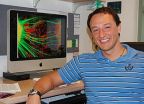IU biologists collaborate to refine climate change modeling tools
New model includes critical plant-soil interaction processes in climate assessments
2014-11-11
(Press-News.org) A new climate change modeling tool developed by scientists at Indiana University, Princeton University and the National Oceanographic and Atmospheric Administration finds that carbon dioxide removal from the atmosphere owing to greater plant growth from rising CO2 levels will be partially offset by changes in the activity of soil microbes that derive their energy from plant root growth.
Soils hold more carbon than all of the earth's plant biomass and atmosphere combined. The new work published by Benjamin N. Sulman, a postdoctoral researcher in the lab of co-author and IU Department of Biology associate professor Richard P. Phillips, identifies the highly active community of chemicals and organisms in the rhizosphere, or the soil that surrounds roots, as the driver behind increased emissions.
"The deposition of compounds such as sugars and organic acids from living roots can increase the activity of bacteria and fungi, and it's this increase in activity that accelerates the decomposition of carbon in the soil, leading to higher CO2 emissions," Sulman said. "On the other hand, this increased activity can transform carbon compounds into forms more easily locked onto soil particles, allowing them to stay in the soil for longer periods of time."
Global simulations conducted by the team found that microbial responses to enhanced root activity under rising CO2, while depending on plant species, climate and soil mineralogy, led to a loss of global soil carbon stocks that counteracted the additional carbon storage resulting from increased plant growth in many regions of the world. The strongest of these effects were found in temperate North America, Western Europe, Southeast Asia and Southern Africa, while gains in soil carbon capture were greatest in boreal North America, Siberia and tropical South America.
Prior to the new research published today in Nature Climate Change, computer models used to simulate future climate change generally had not been able to simulate interactions between plant growth and microbial decomposition rates. The new modeling tool -- Carbon, Organisms, Rhizosphere and Protection in the Soil Environment, or CORPSE -- represents a major advance in the ability of scientists to simulate the global carbon cycle.
The model has already been integrated into the next generation of the global land model used for climate simulations by the NOAA Geophysical Fluid Dynamics Laboratory, a major national climate modeling center.
"This model will allow critical plant-soil interaction processes to be included in future climate assessments," Phillips said. "To not consider how microbes influence soil carbon in offsetting ways, promoting losses through enhanced decomposition but gains by protecting soil carbon, would lead to overestimates or underestimates of the role soils play in influencing global climate."
Simulations for the experiments were projected over a 30-year period and found that root-microbe interactions stimulated protection of carbon in soils where cold temperatures limited decomposition (high altitudes), and in regions like tropical South America where high soil clay content allowed carbon compounds to be locked onto mineral particles, protecting them from microbial decomposition. Rapid decomposition facilitated by warm temperatures and abundant moisture in these same tropical regions slowed the accumulation of organic matter that was not protected from microbial decomposers.
Model simulations can always be improved by testing predictions against field data collected from different ecosystems, and Sulman and Phillips are doing just that: investigating how roots influence soil decomposition and protected forms of carbon in forests that vary in the composition of tree and microbial communities.
"These experiments will enable us to further test and refine the underlying processes in the CORPSE model and should lead to improved predictions of the role of plant-soil interactions in global climate change," Sulman said.
INFORMATION:
"Microbe-driven turnover offsets mineral-mediated storage of soil carbon under elevated CO2" appeared online today in Nature Climate Change. Co-authors with Sulman and Phillips were A. Christopher Oishi of the U.S. Forest Service and Elena Shevliakova and Stephen W. Pacala, both of Princeton University.
Funding for the research was provided by the U.S. Department of Commerce, the U.S. Department of Agriculture's SFRI Program, BP and Princeton University. Global simulations were supported by the Geophysical Fluid Dynamics Laboratory using the Gaea supercomputer of the National Climate-Computing Research Center at Oak Ridge National Laboratory.
[Attachments] See images for this press release:

ELSE PRESS RELEASES FROM THIS DATE:
2014-11-11
INDIANAPOLIS -- A new treatment regimen for hepatitis C, the most common cause of liver cancer and transplantation, has produced results that will transform treatment protocols for transplant patients, according to research published online today in the New England Journal of Medicine.
The investigational three-drug regimen, which produced hepatitis C cure rates of 97 percent, is an oral interferon-free therapy. Previously, the typical treatment for hepatitis C after a liver transplant was an interferon-based therapy, usually given for 48 weeks. It had a much lower response ...
2014-11-11
Lead researcher, Dr Sarah Dunstan from the Nossal Institute of Global Health at the University of Melbourne said the study is the first large-scale, unbiased search for human genes that affect a person's risk of typhoid.
Enteric fever, or typhoid fever as it more commonly known, is a considerable health burden to lower-income countries.
This finding is important because this natural resistance represents one of the largest human gene effects on an infectious disease.
"We screened the human genome to look for genes associated with susceptibility to, or resistance ...
2014-11-11
Weeds in the UK are still evolving hundreds of years after their introduction and are unlikely to have yet reached their full potential as invaders, UNSW Australia scientists have discovered.
The study is the first to have tracked the physical evolution of introduced plant species from the beginning of their invasion to the present day, and was made possible by the centuries-old British tradition of storing plant specimens in herbaria.
The research team, led by Habacuc Flores-Moreno, looked at three common weeds - Oxford ragwort, winter speedwell and a willow herb - which ...
2014-11-11
A controversial medication used by breastfeeding women should not be restricted because of the benefits it offers mothers and their babies, according to researchers at the University of Adelaide.
The medication domperidone has recently been the subject of warnings from the European Medicines Agency based on research that there is a link between the medication and fatal heart conditions.
Domperidone has been banned in the United States for years because of fatal cardiac arrhythmias among cancer patients who had been prescribed the drug to prevent nausea and vomiting.
However, ...
2014-11-11
This news release is available in German. X-rays are widely used in medicine and in materials science. To take a picture of a broken bone, it is enough to create a continuous flux of X-ray photons, but in order to study time-dependent phenomena on very short timescales, short X-ray pulses are required. One possibility to create short hard X-ray pulses is hitting a metal target with laser pulses. The laser rips electrons out of the atoms and makes them emit X-ray radiation. Electrical engineers at the Vienna University of Technology (TU Wien) together with researchers ...
2014-11-11
With the help of mouse models, induced pluripotent stem cells (iPSCs) and the "tooth fairy," researchers at the University of California, San Diego School of Medicine have implicated a new gene in idiopathic or non-syndromic autism. The gene is associated with Rett syndrome, a syndromic form of autism, suggesting that different types of autism spectrum disorder (ASD) may share similar molecular pathways.
The findings are published in the Nov. 11, 2014 online issue of Molecular Psychiatry.
"I see this research as an example of what can be done for cases of non-syndromic ...
2014-11-11
An international research team led by Dan Distel, director of the Ocean Genome Legacy Center of New England Biolabs at Northeastern University, has discovered a novel digestive strategy in shipworms. The breakthrough, the researchers say, may also be a game-changer for the industrial production of clean biofuels.
To start, it's important to note that shipworms, the so-called "termites of the sea," aren't actually worms--they're bizarre clams that ...
2014-11-11
WASHINGTON - Hospital workers who deal directly with patients wash their hands less frequently as their workday progresses, probably because the demands of the job deplete the mental reserves they need to follow rules, according to new research published by the American Psychological Association.
Researchers led by Hengchen Dai, a PhD candidate at the University of Pennsylvania, looked at three years of hand-washing data from 4,157 caregivers in 35 U.S. hospitals. They found that "hand-washing compliance rates" dropped by an average of 8.7 percentage points from the beginning ...
2014-11-10
The Assyrian Empire once dominated the ancient Near East. At the start of the 7th century BC, it was a mighty military machine and the largest empire the Old World had yet seen. But then, before the century was out, it had collapsed. Why? An international study now offers two new factors as possible contributors to the empire's sudden demise - overpopulation and drought.
Adam Schneider of the University of California, San Diego and Selim Adalı of Koç University in Istanbul, Turkey, have just published evidence for their novel claim.
"As far as we know, ...
2014-11-10
Results of a federally-funded pooled analysis of five prospective cohort studies indicate that cigarette smoking prior to the first diagnosis of lung (stage I), bladder, kidney or head and neck cancer increases risk of developing a second smoking-associated cancer. This is the largest study to date exploring risk of second cancers among current smokers.
An analysis of five large, prospective cohort studies indicates that lung (stage I), bladder, kidney and head and neck cancer survivors who smoked 20 or more cigarettes a day prior to their cancer diagnoses have an up ...
LAST 30 PRESS RELEASES:
[Press-News.org] IU biologists collaborate to refine climate change modeling tools
New model includes critical plant-soil interaction processes in climate assessments






